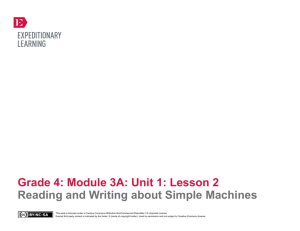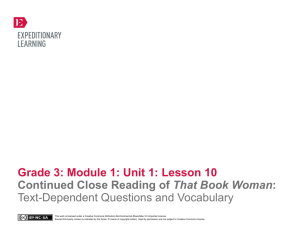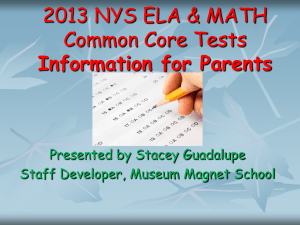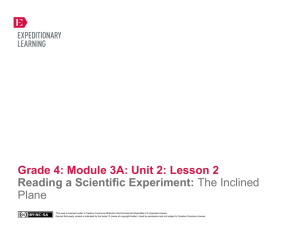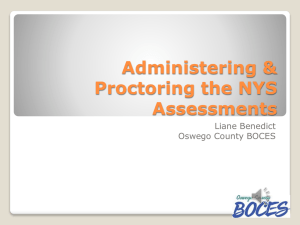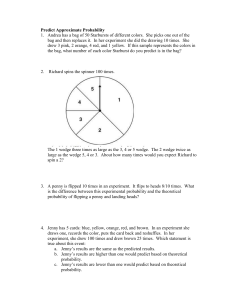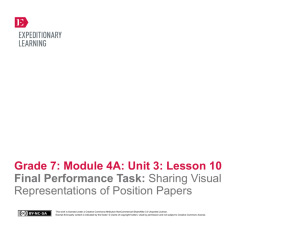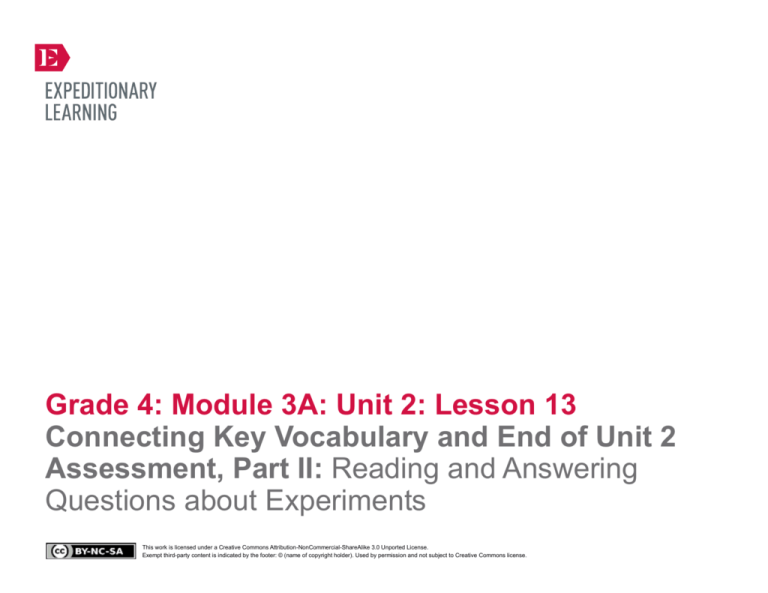
Grade 4: Module 3A: Unit 2: Lesson 13
Connecting Key Vocabulary and End of Unit 2
Assessment, Part II: Reading and Answering
Questions about Experiments
This work is licensed under a Creative Commons Attribution-NonCommercial-ShareAlike 3.0 Unported License.
Exempt third-party content is indicated by the footer: © (name of copyright holder). Used by permission and not subject to Creative Commons license.
GRADE 4: MODULE 3A: UNIT 2: LESSON 13
Connecting Key Vocabulary and End of Unit 2 Assessment, Part II:
Reading and Answering Questions about Experiments
Long-Term Targets Addressed (Based on NYSP12 ELA CCLS)
I can explain the main points in a scientific text, using specific details in the text. (RI.4.3)
I can describe the organizational structure in an informational text (chronology). (RI.4.5)
I can determine the meaning of academic words or phrases in an informational text. (RI.4.4)
I can determine the meaning of content words or phrases in an informational text. (RI.4.4)
I can write informative/explanatory texts that convey ideas and information clearly. (W.4.2)
Supporting Learning Targets
Ongoing Assessment
• I can explain what happens before, during, and after a scientific experiment.
• End of Unit 2 Assessment, Part II: Reading and
Answering Questions about Experiments
• I can document what I observe during a scientific experiment.
• I can construct a conclusion statement that describes what I learned about wedges.
Copyright © 2013 by Expeditionary Learning, New York, NY. All Rights Reserved.
NYS Common Core ELA Curriculum • G4:M3A:U2:L13 • June 2014 •
1
GRADE 4: MODULE 3A: UNIT 2: LESSON 13
Connecting Key Vocabulary and End of Unit 2 Assessment, Part II:
Reading and Answering Questions about Experiments
Agenda
Teaching Notes
1. Opening
• In Part II of the End of Unit 2 Assessment, students read and answer questions about an experiment,
then conduct and write about the results of an experiment.
A. Reviewing Learning Targets (5 minutes)
2. Work Time
A. Reviewing the Scientific Method: Concentric Circles
(10 minutes)
B. End of Unit Assessment, Part II: Answering
Questions about Experiments (35 minutes)
3. Closing and Assessment
A. Tracking My Progress (10 minutes)
• In advance: Prepare materials for students to conduct the experiment (Simple Machines: Forces in
Action, page 14). If materials are limited, consider having students conduct the experiment with a
partner or in small groups and then asking them to answer questions individually.
• Consider what your classroom expectations are for conducting this experiment during the assessment,
as many students will likely be reading or writing while others conduct the experiment.
• Before distributing the text Simple Machines: Forces in Action to students, use a large sticky note or
strip of paper to cover up the “How Does It Work?” box on the top half of page 15.
• Post: Learning targets.
4. Homework
A. Make some observations and record a list of types of
work that you see on your way home or at home that
you think could be made easier with a simple
machine.
B. Continue reading in your independent reading book
for this unit at home.
Copyright © 2013 by Expeditionary Learning, New York, NY. All Rights Reserved.
NYS Common Core ELA Curriculum • G4:M3A:U2:L13 • June 2014 •
2
GRADE 4: MODULE 3A: UNIT 2: LESSON 13
Connecting Key Vocabulary and End of Unit 2 Assessment, Part II:
Reading and Answering Questions about Experiments
Lesson Vocabulary
Materials
scientific process, hypothesis,
observations, conclusion (review from
previous lessons)
• Equity sticks
• Scientific Method anchor chart (from Lesson 2)
• End of Unit 2 Assessment, Part II: Reading and Answering Questions about Experiments (one per student)
• Simple Machines: Forces in Action pages 14–15 (with top of page 15 covered) (book; one per student)
• Tracking My Progress, End of Unit 2, Part II recording form (one per student)
• End of Unit 2 Assessment, Part II: Reading and Answering Questions about Experiments (answers, for teacher reference)
• 2-Point Rubric: Writing from Sources/Short Response (for teacher reference)
Meeting Students’ Needs
Opening
A. Reviewing Learning Targets (5 minutes)
• Post and review the following learning targets: “I can explain what happens before, during, and after a scientific
experiment,” “I can document what I observe during a scientific experiment,” and “I can construct a conclusion statement
that describes what I learned about wedges using scientific vocabulary.” Tell students today they get to show what they know
about reading, conducting, and writing about experiments and they will do this with the wedge.
• Have students Think-Pair-Share on the following prompt:
* Based on your experience reading, conducting, and writing about experiments, what do these targets mean? Give evidence
from the experiments we have conducted on simple machines so far.
• Ask pairs to share their specific examples with the class. Listen for students to say things like: “When we experimented with
the inclined plane, we observed _________ and wrote this in our notes,” or “In our experiment with the pulley, we read
__________.”
Copyright © 2013 by Expeditionary Learning, New York, NY. All Rights Reserved.
NYS Common Core ELA Curriculum • G4:M3A:U2:L13 • June 2014 •
3
GRADE 4: MODULE 3A: UNIT 2: LESSON 13
Connecting Key Vocabulary and End of Unit 2 Assessment, Part II:
Reading and Answering Questions about Experiments
Work Time
Meeting Students’ Needs
A. Reviewing the Scientific Method: Concentric Circles (10 minutes)
• Tell students they are going to review the scientific method by discussing questions in Concentric Circles, much like they did
with the guiding question in Lesson 1.
• Using sentence frames can help
ELLs articulate their learning. Using
the word “because” in the sentence
frame helps all students support
their thinking with evidence.
• Ask the students to find a partner and number off 1 and 2 (if there is an odd number of students, triads are fine). Direct all 1s
to form an inner circle (shoulder-to-shoulder) facing out. Then direct the 2s to stand in front of their partners.
• Remind them of the Concentric Circles protocol directions from Lesson 1. Ask the students to discuss the following question:
“Why do scientists conduct experiments?”
• Give students 2 minutes to share. Then use equity sticks to cold call a few pairs and have them share their thinking.
• Have the outside circle move two people to the left to discuss the remaining questions. Have students move as you present
them with each new question.
• When using the Concentric Circles
protocol in a class with an odd
number of students, consider
creating triads to support students
who struggle with verbalizing their
thinking.
* “What is a hypothesis?”
* “Why is careful observation and recording important in an experiment?”
* “What makes a good experiment conclusion?”
• As the students are discussing the topic, circulate and listen for students to reference information on the Scientific Method
anchor chart.
• Have students gather together as a whole group. Post the Scientific Method anchor chart. Review the steps with
students. Ask them to think about these steps as they complete their assessment.
Copyright © 2013 by Expeditionary Learning, New York, NY. All Rights Reserved.
NYS Common Core ELA Curriculum • G4:M3A:U2:L13 • June 2014 •
4
GRADE 4: MODULE 3A: UNIT 2: LESSON 13
Connecting Key Vocabulary and End of Unit 2 Assessment, Part II:
Reading and Answering Questions about Experiments
Work Time (continued)
Meeting Students’ Needs
B. End of Unit 2 Assessment, Part II: Reading and Answering Questions about Experiments (35 minutes)
Note: Students need to keep the top of page 15 in Simple Machines: Forces in Action covered while they are answering
Questions 1 through 9 of this assessment.
• Allow ELLs additional time to
complete their assessment. They
will receive extra time on the New
York State assessment.
• Have students prepare to take the assessment by clearing their table/desk. Distribute the End of Unit 2 Assessment,
Part II: Reading and Answering Questions about Experiments. Review the directions at the top of the assessment
and point out where students should stop and conduct the experiment.
• Explain to students where to perform the experiment when they are ready. Be sure to share the expectations for this portion
of the assessment, as some students will likely still be reading and answering questions when others begin the experiment. If
students are to share or take turns with materials, let them know expectations for this as well.
• Once students are clear on the directions for the assessment distribute the text Simple Machines: Forces in Action
pages 14 and 15. Remind students to keep the top of page 15 covered until they have answered Questions 1 through 9.
• Let students begin. Circulate to support them as they transition to conducting the experiment and writing about the results.
Copyright © 2013 by Expeditionary Learning, New York, NY. All Rights Reserved.
NYS Common Core ELA Curriculum • G4:M3A:U2:L13 • June 2014 •
5
GRADE 4: MODULE 3A: UNIT 2: LESSON 13
Connecting Key Vocabulary and End of Unit 2 Assessment, Part II:
Reading and Answering Questions about Experiments
Closing and Assessment
Meeting Students’ Needs
A. Tracking My Progress (10 minutes)
• Ask students to complete the Tracking My Progress, End of Unit 2, Part II recording form. Collect students’
assessments and Tracking My Progress sheets. Compare students’ reflections on the learning targets to their performance on
this assessment to inform future instruction.
• For students who struggle with
language, consider giving them a list
of key academic and scientific words
they might use in their reflections.
• If students finish early, have them continue their independent reading from this module.
• Congratulate students for working so hard to learn to read scientific text independently. Note their growing knowledge about
simple machines; they will get to apply this as writers during Unit 3.
Meeting Students’ Needs
Homework
• Make some observations and record a list of types of work that you see on your way home or at home that you think could be
made easier with a simple machine.
• Continue reading in your independent reading book for this unit at home.
Copyright © 2013 by Expeditionary Learning, New York, NY. All Rights Reserved.
NYS Common Core ELA Curriculum • G4:M3A:U2:L13 • June 2014 •
6
Grade 4: Module 3A: Unit 2: Lesson 13
Supporting Materials
This work is licensed under a Creative Commons Attribution-NonCommercial-ShareAlike 3.0 Unported License.
Exempt third-party content is indicated by the footer: © (name of copyright holder). Used by permission and not subject to Creative Commons license.
GRADE 4: MODULE 3A: UNIT 2: LESSON 13
End of Unit 2 Assessment, Part II:
Reading and Answering Questions about Experiments
Name:
Date:
Directions:
1. Read page 14 in Simple Machines: Forces in Action.
2. Answer Questions 1 through 7 about the text. Then stop.
3. Conduct the experiment and record your observations for Question 8.
4. Write your conclusion for Question 9.
5. Uncover the “How Does It Work?” box of the text and answer Questions 10 and 11.
1. What is the best description of this text?
A. It compares and contrasts different wedges.
B. It presents a problem that can be solved using a wedge.
C. It explains how a wedge affects work.
D. It gives ordered steps for a procedure using different wedges.
2. Which of the following is NOT a characteristic of this text?
A. diagrams
B. dialogue
C. numbered steps
D. bulleted list
3. What is the purpose of the yellow box at the top of page 14?
Copyright © 2013 by Expeditionary Learning, New York, NY. All Rights Reserved.
NYS Common Core ELA Curriculum • G4:M3A:U2:L13 • June 2014 •
8
GRADE 4: MODULE 3A: UNIT 2: LESSON 13
End of Unit 2 Assessment, Part II:
Reading and Answering Questions about Experiments
4. The diagram at the bottom of page 14 helps the reader to visualize which step in the experiment?
5. How many times is the reader asked to record measurements?
A. twice
B. five times
C. three times
D. once
6. In Step 4, the reader is asked to:
A. Record the distance.
B. Use the skinny wedge.
C. Use the fat wedge.
D. Use a ruler.
7. Reread the text and write your hypothesis: What do you think is going to happen? Use evidence
from the text to support your prediction.
STOP HERE: Conduct the experiment now. Then answer the remaining questions.
Copyright © 2013 by Expeditionary Learning, New York, NY. All Rights Reserved.
NYS Common Core ELA Curriculum • G4:M3A:U2:L13 • June 2014 •
9
GRADE 4: MODULE 3A: UNIT 2: LESSON 13
End of Unit 2 Assessment, Part II:
Reading and Answering Questions about Experiments
Use vocabulary from this word bank to help you answer the questions below.
effort
force
experiment
wedge
simple machine
work
8. Observations: As you conduct this experiment, what do you see happening?
9. Conclusion: Describe what you have learned about the wedge and how it works.
Copyright © 2013 by Expeditionary Learning, New York, NY. All Rights Reserved.
NYS Common Core ELA Curriculum • G4:M3A:U2:L13 • June 2014 •
10
GRADE 4: MODULE 3A: UNIT 2: LESSON 13
End of Unit 2 Assessment, Part II:
Reading and Answering Questions about Experiments
*Uncover the top of page 15 in the text and read the “How Does It Work?” section.
Then answer the following questions.
10. Which explanation of how a wedge affects a force is supported by the text?
A. Pushing down on a wedge increases the force.
B. Pushing down on a wedge does not affect the force.
C. Pushing down on a wedge changes the direction of the force to sideways.
D. Pushing down on a wedge changes the direction of the force upwards.
11. According to the text, how is the distance between the blocks affected by using the thin versus the
thick wedges?
A. Thick wedges take more effort than thin wedges, but move the blocks a greater distance.
B. Thin and thick wedges both move the blocks an equal distance.
C. Thick wedges do not move the blocks.
D. Thick wedges don’t work as well as thin wedges.
Copyright © 2013 by Expeditionary Learning, New York, NY. All Rights Reserved.
NYS Common Core ELA Curriculum • G4:M3A:U2:L13 • June 2014 •
11
GRADE 4: MODULE 3A: UNIT 2: LESSON 13
Tracking My Progress, End of Unit 2, Part II
Name:
Date:
Learning target: I can explain what happens before, during, and after a scientific experiment.
1. The target in my own words is:
2. How am I doing? Circle one.
I need more help to learn this
I understand some of this
I am on my way!
3. The evidence to support my self-assessment is:
Copyright © 2013 by Expeditionary Learning, New York, NY. All Rights Reserved.
NYS Common Core ELA Curriculum • G4:M3A:U2:L13 • June 2014 •
12
GRADE 4: MODULE 3A: UNIT 2: LESSON 13
Tracking My Progress, End of Unit 2, Part II
Name:
Date:
Learning target: I can document what I observe during a scientific experiment.
1. The target in my own words is:
2. How am I doing? Circle one.
I need more help to learn this
I understand some of this
I am on my way!
3. The evidence to support my self-assessment is:
Copyright © 2013 by Expeditionary Learning, New York, NY. All Rights Reserved.
NYS Common Core ELA Curriculum • G4:M3A:U2:L13 • June 2014 •
13
GRADE 4: MODULE 3A: UNIT 2: LESSON 13
Tracking My Progress, End of Unit 2 Assessment, Part II
Name:
Date:
Learning target: I can construct a conclusion statement that describes what I learned about wedges.
1. The target in my own words is:
2. How am I doing? Circle one.
I need more help to learn this
I understand some of this
I am on my way!
3. The evidence to support my self-assessment is:
Copyright © 2013 by Expeditionary Learning, New York, NY. All Rights Reserved.
NYS Common Core ELA Curriculum • G4:M3A:U2:L13 • June 2014 •
14
GRADE 4: MODULE 3A: UNIT 2: LESSON 13
End of Unit 2 Assessment, Part II:
Reading and Answering Questions about Experiments
(Answers, for Teacher Reference)
Standards assessed:
Questions 1, 2, 3, and 4 (RI.4.5); Questions 5, 6, 10, and 11 (RI.4.3); Questions 7, 8, and 9 (W.4.2).
Directions:
1. Read page 14 in Simple Machines: Forces in Action.
2. Answer Questions 1 through 7 about the text. Then stop.
3. Conduct the experiment and record your observations for Question 8.
4. Write your conclusion for Question 9.
5. Uncover the “How Does It Work?” box of the text and answer the remaining Questions 10 and 11.
1. What is the best description of this text?
A. It compares and contrasts different wedges.
B. It presents a problem that can be solved using a wedge.
C. It explains how a wedge affects work.
D. It gives ordered steps for a procedure using different wedges.
2. Which of the following is NOT a characteristic of this text?
A. diagrams
B. dialogue
C. numbered steps
D. bulleted list
3. What is the purpose of the yellow box at the top of page 14?
[Possible Answer] It tells the materials needed for the experiment.
Copyright © 2013 by Expeditionary Learning, New York, NY. All Rights Reserved.
NYS Common Core ELA Curriculum • G4:M3A:U2:L13 • June 2014 •
15
GRADE 4: MODULE 3A: UNIT 2: LESSON 13
End of Unit 2 Assessment, Part II:
Reading and Answering Questions about Experiments
(Answers, for Teacher Reference)
4. The diagram at the bottom of page 14 helps the reader to visualize which step in the experiment?
[Possible Answers] Step 2, Step 4, or Steps 2 and 4
5. How many times is the reader asked to record measurements?
A. twice
B. five times
C. three times
D. once
6. In Step 4, the reader is asked to:
A. Record the distance.
B. Use the skinny wedge.
C. Use the fat wedge.
D. Use a ruler.
Copyright © 2013 by Expeditionary Learning, New York, NY. All Rights Reserved.
NYS Common Core ELA Curriculum • G4:M3A:U2:L13 • June 2014 •
16
GRADE 4: MODULE 3A: UNIT 2: LESSON 13
End of Unit 2 Assessment, Part II:
Reading and Answering Questions about Experiments
(Answers, for Teacher Reference)
Use the attached rubric to score the following questions.
7. Reread the text and write your hypothesis: What do you think is going to happen? Use evidence
from the text to support your prediction.
[Possible Responses]
• Both wedges will push the blocks apart.
• The thick wedge will push the blocks farther apart than the thin wedge.
• It will be harder to push the blocks apart with the thick wedge.
8. Observations: As you conduct this experiment, what do you see happening?
[Possible Answer] When I used put a force down on the blocks using the skinny wedge
the blocks moved _______ inches apart. When I put a force down using the fat wedge
the blocks moved ______ inches apart.
9. Conclusion: Describe what you have learned about the wedge and how it works.
[Possible Answer] In this experiment I learned that the wedge is a simple machine that
pushes things apart. I found that fat wedges move things more than skinny wedges, but
I had to push harder. I think this means you need to use more effort with fat wedges
and less with skinny wedges, but they can both help you do work.
Copyright © 2013 by Expeditionary Learning, New York, NY. All Rights Reserved.
NYS Common Core ELA Curriculum • G4:M3A:U2:L13 • June 2014 •
17
GRADE 4: MODULE 3A: UNIT 2: LESSON 13
End of Unit 2 Assessment, Part II:
Reading and Answering Questions about Experiments
(Answers, for Teacher Reference)
*Uncover the top of page 15 in the text and read the “How Does It Work?” section.
Then answer the following questions.
10. Which explanation of how a wedge affects a force is supported by the text?
A. Pushing down on a wedge increases the force.
B. Pushing down on a wedge does not affect the force.
C. Pushing down on a wedge changes the direction of the force to sideways.
D. Pushing down on a wedge changes the direction of the force upwards.
11. According to the text, how is the distance between the blocks affected by using the thin versus the
thick wedges?
A. Thick wedges take more effort than thin wedges, but move the blocks a greater
distance.
B. Thin and thick wedges both move the blocks an equal distance.
C. Thick wedges do not move the blocks.
D. Thick wedges don’t work as well as thin wedges.
Copyright © 2013 by Expeditionary Learning, New York, NY. All Rights Reserved.
NYS Common Core ELA Curriculum • G4:M3A:U2:L13 • June 2014 •
18
GRADE 4: MODULE 3A: UNIT 2: LESSON 13
2-Point Rubric: Writing from Sources/Short Response1
(For Teacher Reference)
Use the below rubric for determining scores on short answers in this assessment.
2-point Response
The features of a 2-point response are:
Valid inferences and/or claims from the text where required by the prompt
Evidence of analysis of the text where required by the prompt
Relevant facts, definitions, concrete details, and/or other information from
the text to develop response according to the requirements of the
prompt
Sufficient number of facts, definitions, concrete details, and/or other
information from the text as required by the prompt
Complete sentences where errors do not impact readability
1-point Response
The features of a 1-point response are:
A mostly literal recounting of events or details from the text as required by
the prompt
Some relevant facts, definitions, concrete details, and/or other information
from the text to develop response according to the requirements of the
prompt
Incomplete sentences or bullets
0-point Response
The features of a 0-point response are:
A response that does not address any of the requirements of the prompt or
is totally inaccurate
No response (blank answer)
A response that is not written in English
A response that is unintelligible or indecipherable
1From
New York State Department of Education, October 6, 2012.
Copyright © 2013 by Expeditionary Learning, New York, NY. All Rights Reserved.
NYS Common Core ELA Curriculum • G4:M3A:U2:L13 • June 2014 •
19

